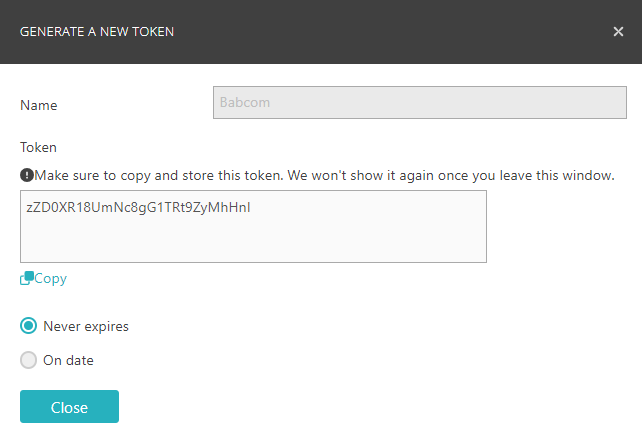Deploy the local TACACS+ server container using Docker on Linux
In this topic, you will learn how to deploy the Portnox™ Cloud local TACACS+ server container using Docker on a local Linux machine (physical or virtual).
Read the following important information before you begin:
-
We assume that the Linux machine is already installed, configured, updated, and connected to the local network. This guide includes only the installation and configuration of Docker and the Portnox Cloud local TACACS+ server container.
Install Docker
In this section, you will learn how to install Docker on the Linux machine.
Skip this section if Docker is already installed.
- Open the Terminal window.
-
Install Docker using your distribution’s package management framework.
Ubuntu:
sudo apt-get install docker.io -yImportant: While the Ubuntu apt repository includes Docker, for production machines Docker recommends using its own apt repository instead. This gives you access to newer versions and additional packages. You can find the relevant instructions in the official Docker documentation.RedHat:
sudo yum install -y yum-utils sudo yum-config-manager --add-repo https://download.docker.com/linux/rhel/docker-ce.repo sudo yum install docker-ce sudo systemctl start docker -
Test Docker using the Hello World test container.
sudo docker run hello-worldResult: Hello from Docker! This message shows that your installation appears to be working correctly.
Run the Portnox Cloud local TACACS+ server container
In this section, you will learn how to deploy the local TACACS+ server Docker container locally to the Linux machine.
-
Copy and paste the values of the three environment variables that you saved
earlier (or copy them directly from Portnox Cloud) into three export
commands.
export TACACS_GATEWAY_ORG_ID=copied_TACACS_GATEWAY_ORG_ID export TACACS_GATEWAY_PROFILE=copied_TACACS_GATEWAY_PROFILE export TACACS_GATEWAY_TOKEN=copied_TACACS_GATEWAY_TOKEN -
Run the portnox/portnox-tacacs Docker container.
sudo docker run -d -p 49:49/tcp \ --name portnox-tacacs --restart=always \ -v portnox-tacacs-data:/data \ -e TACACS_GATEWAY_PROFILE=$TACACS_GATEWAY_PROFILE \ -e TACACS_GATEWAY_ORG_ID=$TACACS_GATEWAY_ORG_ID \ -e TACACS_GATEWAY_TOKEN=$TACACS_GATEWAY_TOKEN \ portnox/portnox-tacacs:latestNote: The -v option creates and mounts a Docker volume that preserves the local TACACS+ server data in case the container stops running, for example, if the machine is restarted or crashes. Without this option, local TACACS+ cached data would be lost if the container stops running. To learn more about Docker volumes and an alternative, bind mounts, see Docker documentation. - Optional:
View the logs for the portnox/portnox-tacacs Docker container.
sudo docker logs portnox-tacacs -f
Result: Your local TACACS+ server is active.
You can check its status in Portnox Cloud, in the section.

Automatically update an existing local server container
In this section, you will learn how to automatically update your Docker container to the latest version by deploying another Docker container: portnox-autoupdate.
-
Find the organization ID:
-
Get an API token from Portnox Cloud:
-
Deploy the portnox-autoupdate Docker container:
sudo docker run --restart=always -d --name portnox-autoupdate \ -v /var/run/docker.sock:/var/run/docker.sock \ -v portnox-autoupdate-logs:/app/logs \ -e AUTO_UPDATE_ORG_ID=your_organization_ID \ -e AUTO_UPDATE_PORTNOX_API_TOKEN=your_API_access_token \ portnox/portnox-autoupdate:latestFor example:
sudo docker run --restart=always -d --name portnox-autoupdate \ -v /var/run/docker.sock:/var/run/docker.sock \ -v portnox-autoupdate-logs:/app/logs \ -e AUTO_UPDATE_ORG_ID=b2973887-1274-45c4-91d0-4a342a861c76 \ -e AUTO_UPDATE_PORTNOX_API_TOKEN=zZD0XR18UmNc8gG1TRt9ZyMhHnl \ portnox/portnox-autoupdate:latest
Remove an existing local TACACS+ container
In this section, you will learn how to manually remove an existing local TACACS+ container.
-
Get the container ID. You will need this ID to delete the container.
sudo docker ps | grep tacacsResult: The first hexadecimal characters will represent the container ID, which you will need for next steps.
For example:
684c073c6a97 portnox/portnox-tacacs:1.1.211 (...) -
Stop the running container.
sudo docker stop container_idFor example:
sudo docker stop 684c073c6a97 -
Delete the container.
sudo docker rm container_idFor example:
sudo docker rm 684c073c6a97 -
Get the image ID. You will need this ID to delete the old image.
sudo docker images | grep radiusResult: The hexadecimal characters in the third column represent the image ID, which you will need for next steps.
For example:
portnox/portnox-radius 1.1.211 e2631eebc94e (...) -
Delete the image.
sudo docker rmi image_idFor example:
sudo docker rmi e2631eebc94e

